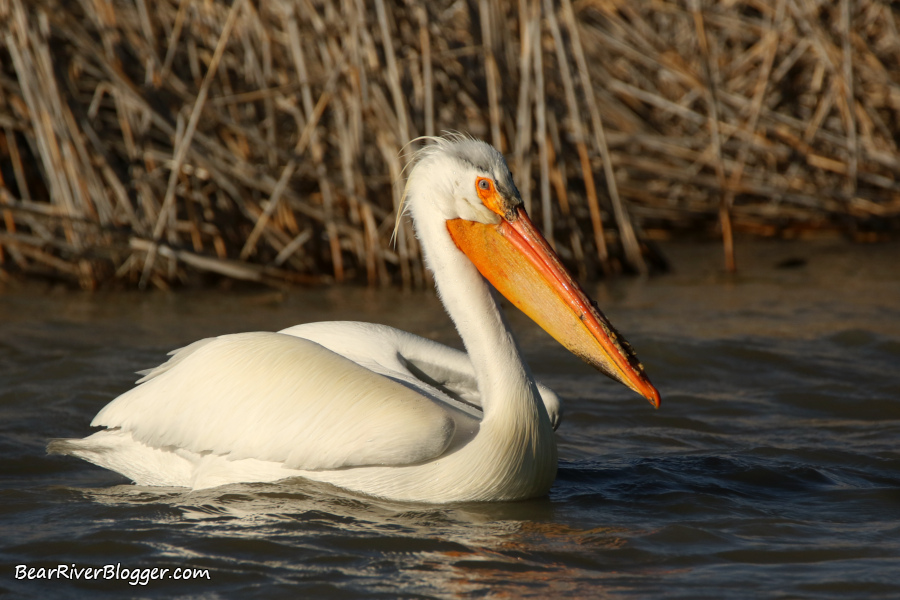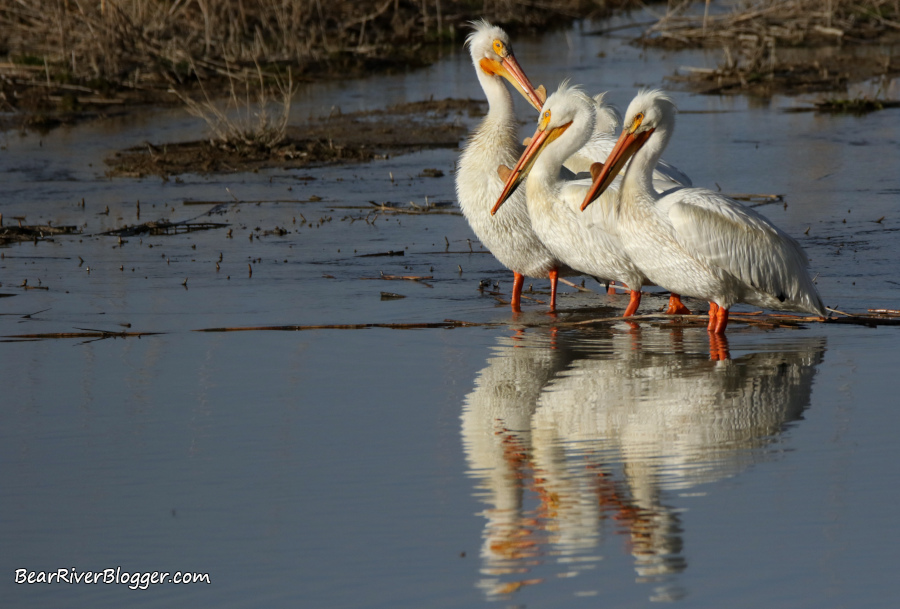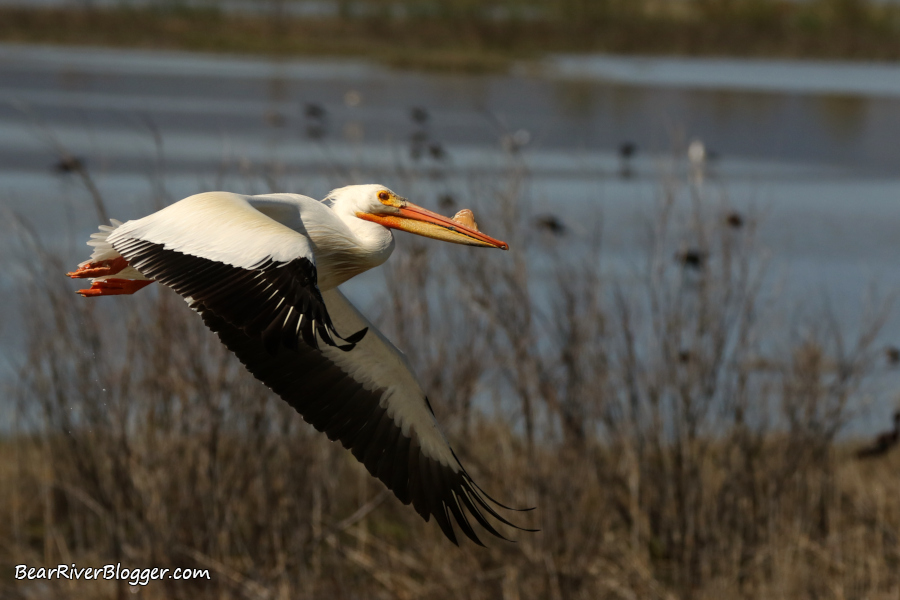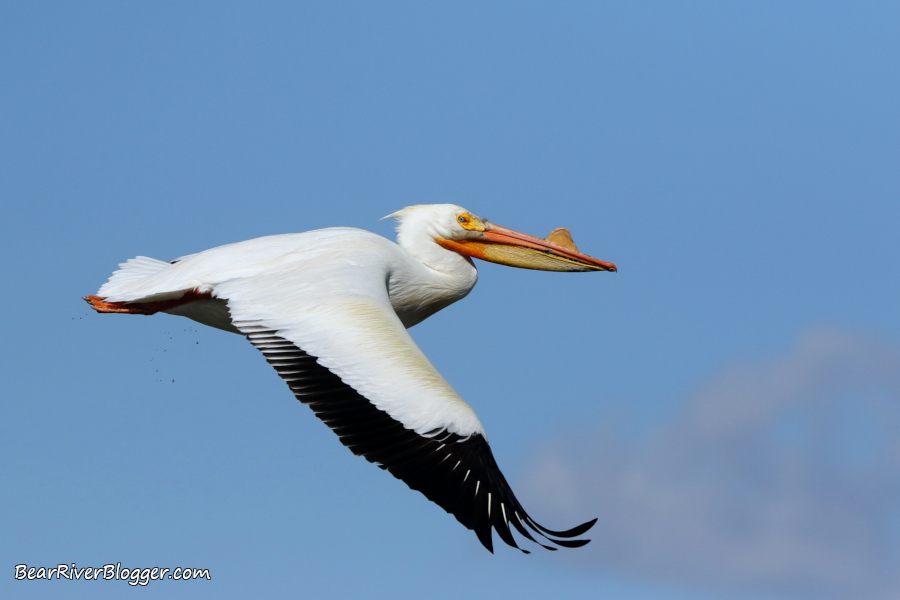If there’s a bird I want to both photograph and write about for this website more than the American white pelican I surely don’t know what it would be.
Don’t get me wrong, however, by that bold statement, I most certainly have lots of other birds I enjoy blogging about but when the opportunity arises, like it did this very morning in fact, to write about pelicans I have to take it and run so I hope you are content with reading about pelicans today.
I just received a press release from the Utah Division of Wildlife Resources that offered some hope regarding the dismal breeding success American white pelicans have been experiencing on Gunnison Island the past few years due to the drought and resulting near-record-low water level of the Great Salt Lake.
I’ll get to the good news in a minute but first, a little back-story about pelicans to put things into perspective.
Historically, Utah is blessed to have one of the largest breeding colonies of American white pelicans in North America, most likely due to both the size and remote nature of Gunnison Island as well as a plentiful source of fish nearby, mainly carp, living in the extensive freshwater wetlands that hug the east shoreline of the Great Salt Lake.
Interestingly enough, I learned from a past email conversation with John Luft, Great Salt Lake Ecosystem Program Manager with the Utah DWR, that the largest number of breeding pelicans he can remember being seen on Gunnison Island was an astounding 21,000 birds.
He further noted waterbird census flights conducted during spring and fall migration timeframes have had over 80,000 pelicans counted on those surveys, an incredible sight a birdwatcher like myself could only dare to imagine and proof positive Utah, namely the Great Salt Lake, its wetlands, and the remote Gunnison Island rookery, plays an important role in the overall ecology for pelicans in North America.
From what I’ve been learning the past few years regarding pelicans here in Utah, there is a pretty obvious connection between levels of the Great Salt Lake and pelican breeding success on Gunnison Island, one that has everything to do with the safety of nesting pelicans on what is supposed to be a remote island rookery of sorts.

Simply put, when water levels drop to the point Gunnison Island is no longer an island completely surrounded and protected by a water barrier, i.e. the Great Salt Lake, land-based disturbances such as coyotes and even humans have a dramatic effect on pelican breeding success and that very thing, unfortunately, is what has been happening to this pelican rookery the past several years.
In fact, Luft noted low water levels have been a problem for many years and, as a result, coyotes have been accessing Gunnison Island since at least 2016 but last year was the first total nesting abandonment they have seen on the island.
Luft further mentioned even though pelicans are colony nesting birds these large flocks are still extremely susceptible to disturbances and will abandon their nests as such, giving cause why both Gunnison and Hat Islands, wildlife management areas owned by the Utah DWR and located in remote areas of the Great Salt Lake, are protected by a 1-mile halo around each respective island from any and all public access.
Even though pelicans can live 20 years or more, giving a good reason why they instinctively return to Gunnison Island each year despite the recent disturbances, biologists are concerned that if this trend continues and the pelicans are unsuccessful in rearing a chick year after year, these most graceful birds on the wing might eventually give up on Gunnison Island altogether and look elsewhere to nest, something that seems to possibly be starting this year, in fact, hence the reason for this blog post.
Last year, in particular, Luft noted there were approximately 3,000 nests on Gunnison Island in May with less than 1,000 young pelicans in June and, sadly, that number drastically crashed to 50 young birds during the DWR’s July census flight over the island.
(American White Pelican Feeding Frenzy. For short nature photography tips and interesting stories about the natural world around us, subscribe to our Bear River Blogger channel on YouTube for videos and updates from our travels while out in nature, both on and off of the famed Bear River Migratory Bird Refuge.)
An additional flight in the area of Gunnison Island to survey another species a couple weeks later resulted in no pelicans remaining on Gunnison Island with what Luft termed as a total nest abandonment, one most likely due to land-based disturbances of some kind, possibly human but most likely coyote, from extremely low water levels in the Great Salt Lake now supplying a land bridge between the mainland and the island.
To put things into perspective, the average number of pelican nests found on Gunnison Island for each breeding season during the last 10 years was 4,290 with 8,580 breeding adults so, in comparison, both 2022 and 2023 had numbers showing about 2,900 nests and roughly 5,800 breeding adults, the lowest number since the 1970s and down quite a bit from what is normally to be expected on the island in recent observations.
Needless to say, the very low water levels of the Great Salt Lake have been making it hard for pelicans to nest on Gunnison Island in recent years as pelicans are known to be very susceptible to disturbances during nesting season which is why they prefer to nest in large colonies on very remote locations such as Gunnison Island.
The good news I received this morning was actually two-fold with the first part being Utah DWR biologists have now confirmed from a survey conducted in late April that pelicans are currently nesting on Hat Island, another remote island in the Great Salt Lake, for the first time since 1943.

Unlike Gunnison Island which is stashed away in the far northern corner of the lake, Hat Island is located in the southern arm of the Great Salt Lake, approximately due west of Antelope Island, where water levels are rising a bit faster than the north arm from the above-normal water year Utah has been experiencing this spring.
Luft believes the pelicans are possibly nesting on Hat Island due to experienced adults being a little “gun shy” about nesting on Gunnison Island after last year’s disturbances that led to a total colony abandonment.
This theory makes perfect sense and definitely reinforces his statement about pelicans being very susceptible to disturbances during nesting season as well as gives the notion that pelicans are quite intelligent birds and, as such, do remember last year’s disturbances and, as a result, are trying to adapt to changing conditions during nesting season to continue breeding in their traditional Great Salt Lake nesting territory.
Hat Island offers similar nesting conditions to Gunnison Island with each one being remotely situated in the western portion of Great Salt Lake but still close enough for breeding pelicans to fly to the rich food sources offered by the eastern GSL wetlands, places like Farmington Bay and the Bear River Migratory Bird Refuge as two well-known examples.
Hopefully, if enough water reaches the southern arm before the summer evaporation starts maybe, just maybe, Hat Island might once again be surrounded by the salty waters of the Great Salt Lake and offer protection to the pelicans from coyotes and other land-based disturbances that have been causing havoc on Gunnison Island the past few years.

Only time will tell but let’s hope there’s enough water to help refill the GSL to at least where all the islands in the lake can return to being what nature intended them to be in the first place, islands.
The second bit of good news I received this morning was, in addition to utilizing Hat Island this spring for nesting, some pelicans have also returned to and are nesting on Gunnison Island, a small but pleasant surprise I’d say taking into consideration last year’s total nest abandonment.
Utah DWR wildlife biologist John Neill mentions pelicans take about four years to reach breeding maturity and it’s possible that these first-time breeding pelicans likely think conditions on Gunnison Island will be similar to what they experienced and remember from four years ago on the island.
Neill further postulates since pelicans like to stick together in groups adult pelicans that might have nested somewhere other than Gunnison Island last year may have followed these younger breeding adults to the island this season.
That logic makes perfect sense to me and I hope both breeding populations are successful this year no matter why or which island they are nesting on, I just want more pelicans to both watch and photograph on places like the Bear River Migratory Bird Refuge auto tour route and Farmington Bay WMA, both places that offer good opportunities for you and me to find and enjoy pelicans.

With regards to this year’s breeding population, initial numbers from the Utah Division of Wildlife Resources estimate around 800 birds are currently on Gunnison Island and around 1,300 pelicans are simultaneously on Hat Island but surveys are still ongoing and pelicans are still arriving on both of these nesting colonies so final numbers won’t be known for a while just yet.
Either way, it is great to hear pelicans are once again nesting on Gunnison Island as well as giving Hat Island another try after all these years.
Let’s hope for the best for both of these nesting colonies of pelicans this year and always remember if we want to have an abundance of bird life here in northern Utah the Great Salt Lake plays a very important role for a large number of migratory birds, not just pelicans, and if we lose the lake we will lose a lot, if not all, of the wildlife that depends upon it.

We are starting to see what low water levels in the Great Salt Lake do to breeding pelicans, let’s not wait until more bird species are adversely affected before real efforts are made to save the Great Salt Lake.
And if you are unfamiliar with the overall splendor of the Great Salt Lake and why it’s worth saving, a beauty that transcends far more than just birdwatching alone, take some time and visit the lake itself and learn more about what it is all about.
If for nothing else, go and experience first-hand one of the most spectacular reflective sunsets a glass-smooth Great Salt Lake can produce, and that in and of itself stands as a great reason why the lake is worth saving and deserves more water to be left in the rivers that feed it throughout the entire year.
Subscribe And Follow Bear River Blogger
If you are a lot like me, an avid birdwatcher and nature photographer who loves to be outdoors, especially around the Great Salt Lake and its wetlands, I offer you to head on over to our subscribe page and sign up for email notifications for future blog posts about our love for nature, including the famous Bear River Migratory Bird Refuge.
For those of you who utilize the technology of social media, we have also started a Bear River Blogger Facebook page you can follow where we post updates and images about the famous Bear River Migratory Bird Refuge auto tour route, as well as other natural places of interest, that are too small for a blog post here on this website.






